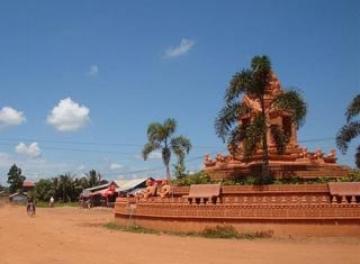Oddor Meanchey Travel Guides

General Information
Oddar Meanchey is one of the smallest provinces of Cambodia located in the far Northwest bordering with Thailand. Its name means Victory Province and the provincial capital is called Samraong. This area was formerly known as Phanomsok, a province of Thailand, which was ceded to French Indochina in 1906, and now remains a part of Cambodia. This province is also a recent creation that was carved out of Siem Reap Province, which the government did not control for much of the 1980s and 1990s.
The countryside is covered by the Dangrek Mountains (or escarpment, as they are sometimes called), which was an optimal shelter for the Khmer Rouge to hide. It is a very remote province that has been a notorious place, because this is where he nastiest of the nasty Khmer Rouge made their last stand. The diabolical Pol Pot and his seemingly bloodthirsty henchmen, Nuon Chea, Ta Mok, Son Sen and Khieu Samphan holed up here for the last years of the Khmer Rouge's existence (another of the henchmen, Ieng Sary, already worked out a surrender and defection deal with the government in 1996).
Pol Pot died mysteriously here, after a supposed power struggle within the power elite (he had Son Sen and his family murdered) and after a controversial show trial. The debate focused on whether it was real or just a sham staged for the outside world to try to legitimize remaining Khmer Rouge figures. The trial took place in the power centre of the Khmer Rouge, the village of Anlong Veng. Pol Pot died mysteriously after he was sentenced to house arrest and the international community began real efforts (for the first time ever) to capture and put this butcher on trial.
His henchmen had more than enough reasons to believe that he wasn't dead at that point, because a Pol Pot on trial, as the ringleader most responsible for the genocide wrought upon his fellow countrymen, would probably have tried to shift portions of the blame (rightfully in the case of these guys) to the rest of the power elite.
The Khmer Rouge kept fragmenting after that and Nuon Chea and Khieu Samphan worked out a surrender-amnesty deal with the Cambodian government and Ta Mok (also called The Butcher) was subsequently captured and is still awaiting a trial in Phnom Penh. As of March 2000, the United Nations and the Cambodian government finally seem set to come up with an agreement on putting the top surviving members of the Khmer Rouge regime on trial in Cambodia, with assistance from and in a partnership with the International Community. Stay tuned though, as this has been a real political football with seemingly more concern for one-upsmanship and personal gain than justice for the dead and surviving victims of Khmer Rouge brutality.
The international border is 14.5 km from the circle in Anlong Veng (Anlong Veng-Choam-Choam- Srawngam and O Smach-Chong Jom). There are plenty of tanks and tank shells to look at along the way and also a strange site in the form of a boulder that had Khmer Rouge soldiers carved out of the sides of it- they have all been decapitated since government forces took control of Anlong Veng. Anyway, it's an interesting little ride to a low-lying part of the Dangkrek Mountains. The road is in fairly good shape with the exception of the climb up a rocky hillside near the border.
Geography
Oddor Meanchey province is 6,158 square kilometres big. It's located in the far Northwest of the country and is bordering to the North with a lengthy borderline to Thailand, to the East with Preah Vihear, to the West with Banteay Meanchey and Siem Reap to the South. In the North the province consists of the re-known Dangkrek Mountains, which are more or less the hill foods of the massive mountain range (the real Dangkrek Mountains) coming from Thailand. There is a nice interesting wildlife sanctuary called Kulen Promtep in the Southeast of the province. The rest of the province is an agricultural used strip, where the illegal logging of the 1980s and 1990s shows its rampant face.
Population
The current population in this province is about 102,835 people or 0,7% of the country?s total population (14,363,519 person in Cambodia, 2007, provincial government data), with 52,650 male and 50,185 female. The population density is therefore 16,7 people per square kilometre.
Climate
The country has a tropical climate - warm and humid. In the monsoon season, abundant rain allows for the cultivation of a wide variety of crops. This year-round tropical climate makes Cambodia ideal for developing tourism. Travellers need not to fear natural disasters such as erupting volcanoes or earthquakes, and the country is not directly affected by tropical storms.
Climate: Cambodia can be visited throughout the year. However, those plans to travel extensively by road should be avoided the last two months of the rainy season when some countryside roads may be impassable. The average temperature is about 27 degrees Celsius; the minimum temperature is about 16 degrees. December and January are the coolest months, whereas the hottest is April.
General information about the provincial climate:
- Cool season: November- March (22c-28c)
- Hot season: March- May (27c -35c)
- Rainy season: May - October (24c-32c, with humidity up to 90%.)
Economy
The province's economy is 93% based on farming and the remaining other 7% are based on fishing and trading. Because of its border with Thailand, the international trade is also booming and becoming another important sector of the province's economy. There is several developing plans from province based NGO's, the Ministry of Foreign Affairs from Thailand and Cambodian government itself. The economy and infrastructure of the province was sustainably destructed during the Khmer Rouge stand and needs therefore a whole new stabile backbone.
ARE YOU LOOKING FOR BUS TICKETS, HERE YOU CAN BOOK IN ADVANCE








